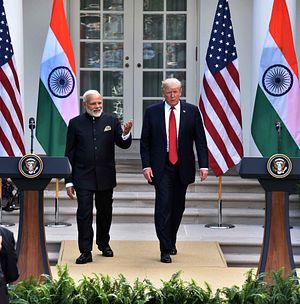The inaugural round of India-U.S. 2+2 Dialogue will be held in New Delhi this week, a significant development reflective of the growing convergence of strategic interests between the world’s oldest and largest democracies. Minister of External Affairs minister Sushma Swaraj and Minister of Defense Nirmala Sitharaman will host both Secretary of State Mike Pompeo and Defense Secretary James Mattis on September 6, where a host of strategic issues will be discussed.
One issue that will certainly dominate the discussions is the Communications Compatibility and Security Agreement (COMCASA). With U.S.-India defense ties on an upward swing in recent years and the Trump administration looking to cultivate partners like New Delhi as it operationalizes the so-called free and open Indo-Pacific (FOIP) strategy, there are reports suggesting that the two sides are moving closer to the signing of the agreement.
Before leaving office, U.S. President Obama categorized India as a “Major Defense Partner.” The Trump administration’s recent decision to give India the STA-1 status (Strategic Trade Authorization-1) is a clear acknowledgement of the growing synergy between India and the United States on the defense and security developments in the Indo-Pacific and beyond but also a recognition of India’s export control regimes being in line with global norms. So far, this status has been accorded only to the NATO countries and Australia, Japan and South Korea, a clear indication of India’s importance in the U.S. strategic calculus.
In an effort to elevate ongoing defense cooperation between India and the United States to a more meaningful level, the United States had sought to have India sign the last two of the four so-called foundational agreements – the General Security of Military Information Agreement (GSOMIA), the Logistics Supply Agreement (LSA) or what is now called the Logistics Exchange Memorandum of Agreement (LEMOA), the Communication and Information Security Memorandum of Agreement (CISMOA) or what is now called the Communications Compatibility and Security Agreement (COMCASA) to suggest a more India-specific agreement, and the Basic Exchange and Cooperation Agreement (BECA).
India signed the GSOMIA in 2002 and the LEMOA in 2016. Ever since the signing of the LEMOA, COMCASA has been the focus. Simply put, COMCASA will allow for greater access to critical communication networks to enable better interoperability between the Indian and U.S. militaries. This will facilitate installation of high-end security gadgets on the many defense equipment and weapon systems that India is buying from the United States.
For instance, many defense platforms that India has bought from the United States are stripped-down versions without some of the more advanced electronic equipment. Security analysts have written about the case of the P-8I maritime aircraft that India has purchased for its Indian Navy which has none of the secure voice and data links – Data Link-11 and Data Link-16 which the other COMCASA-signed countries have been provided with. These data links are essential to have better interoperability through which a common tactical picture is developed between partner navies.
Absence of a COMCASA agreement, in the air platform context, would mean the absence of “precision Global Positioning System (GPS) gear, and state-of-the-art guidance” in some of systems that India is planning to buy. Analysts contend that signing the COMCASA becomes particularly important as India is set to buy the combat version of Sea Guardian drones from the United States.
It remains unclear if India and the United States have been able to iron out all their differences and are ready to sign the agreement at the 2+2 dialogue. Like the LEMOA, there have been heated debates on COMCASA too. There are analysts who argue that COMCASA will “facilitate vertical and horizontal penetration by the US of India’s most sensitive government and military communications grids, including the nuclear Strategic Forces Command – the reason why the armed services are against signing it.” Proponents of this line of view have further called the BJP government “naïve and gullible” to buy into U.S. assurances that the information gathered from Indian systems won’t be shared with other countries.
A few others have questioned the growing closeness between New Delhi and Washington, saying that signing these military agreements will essentially “foreclose India’s options.” While some of these analysts see certain tactical benefits to signing these military pacts, according to them, there are “many more negative geopolitical and strategic consequences to becoming America’s military ally in all but name.” Such analysts believe that the BJP government in New Delhi is moving forward with US ties without these being debated and altering the course of India’s “geostrategics and foreign policy.”
Concerns have also been raised as to how signing COMCASA will “enhance Russia’s fears of compromising its high-value platforms, such as the leased Akula-class nuclear-powered attack submarine and the Su-30MKI combat aircraft” and that it will cause trouble with Russia.
But other analysts have argued that in the absence of the COMCASA-agreement, platforms that India buys from the United States will be less capable. Others have also pointed out that COMCASA can facilitate cooperation on areas such as Maritime Domain Awareness (MDA), which is critical for India considering China’s foray into Indian Ocean. Retired naval officials also write about the “operational imperative” for the Indian military.
Given the disadvantages of not having the COMCASA, there is little doubt that India will sign the agreement at some point. But in typical fashion, India will likely take its own time to make its decision, and some of the aforementioned concerns are likely to linger as well. That should not obscure the fact that for New Delhi, ultimately, signing the COMCASA agreement is really a matter of when rather than if.

































